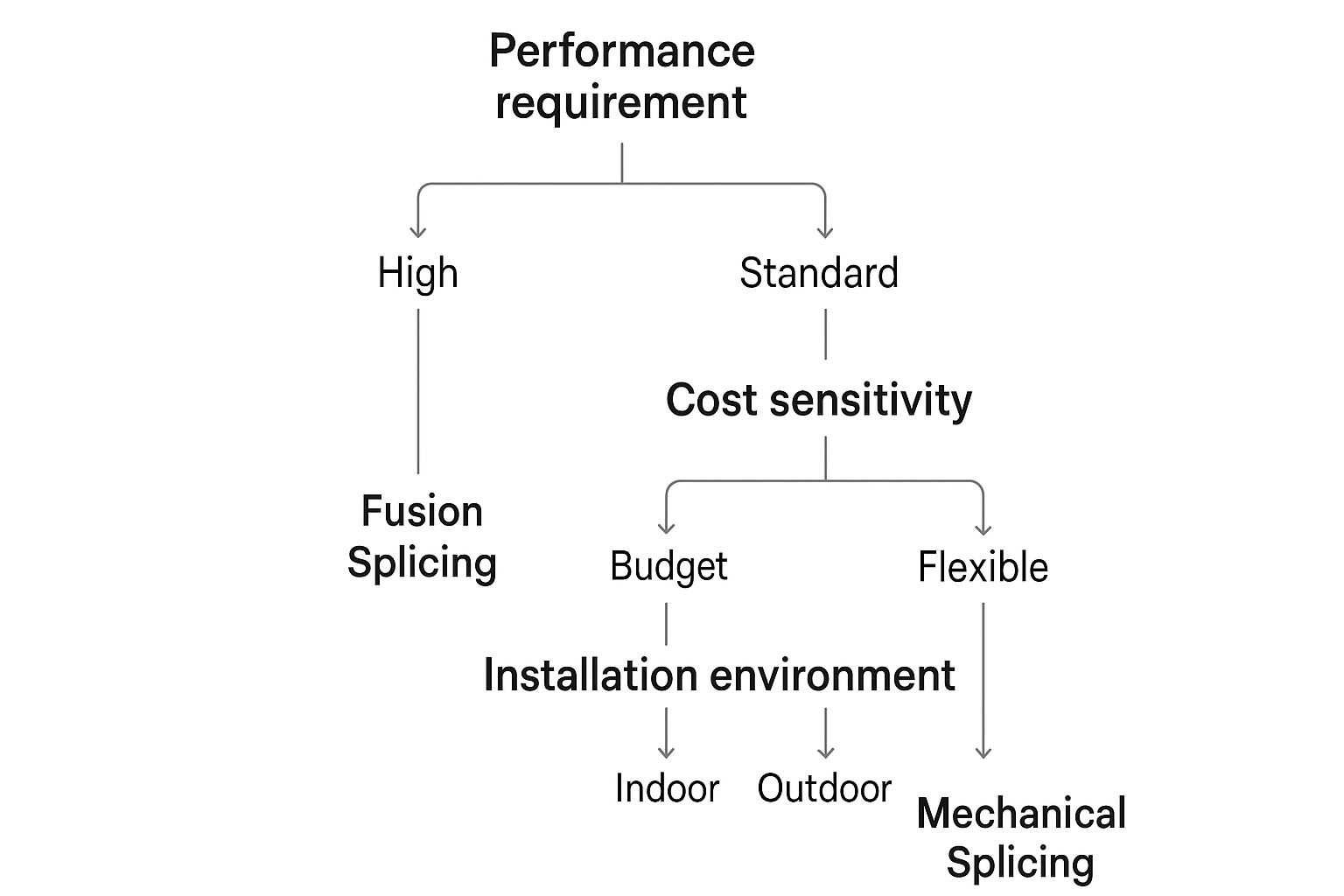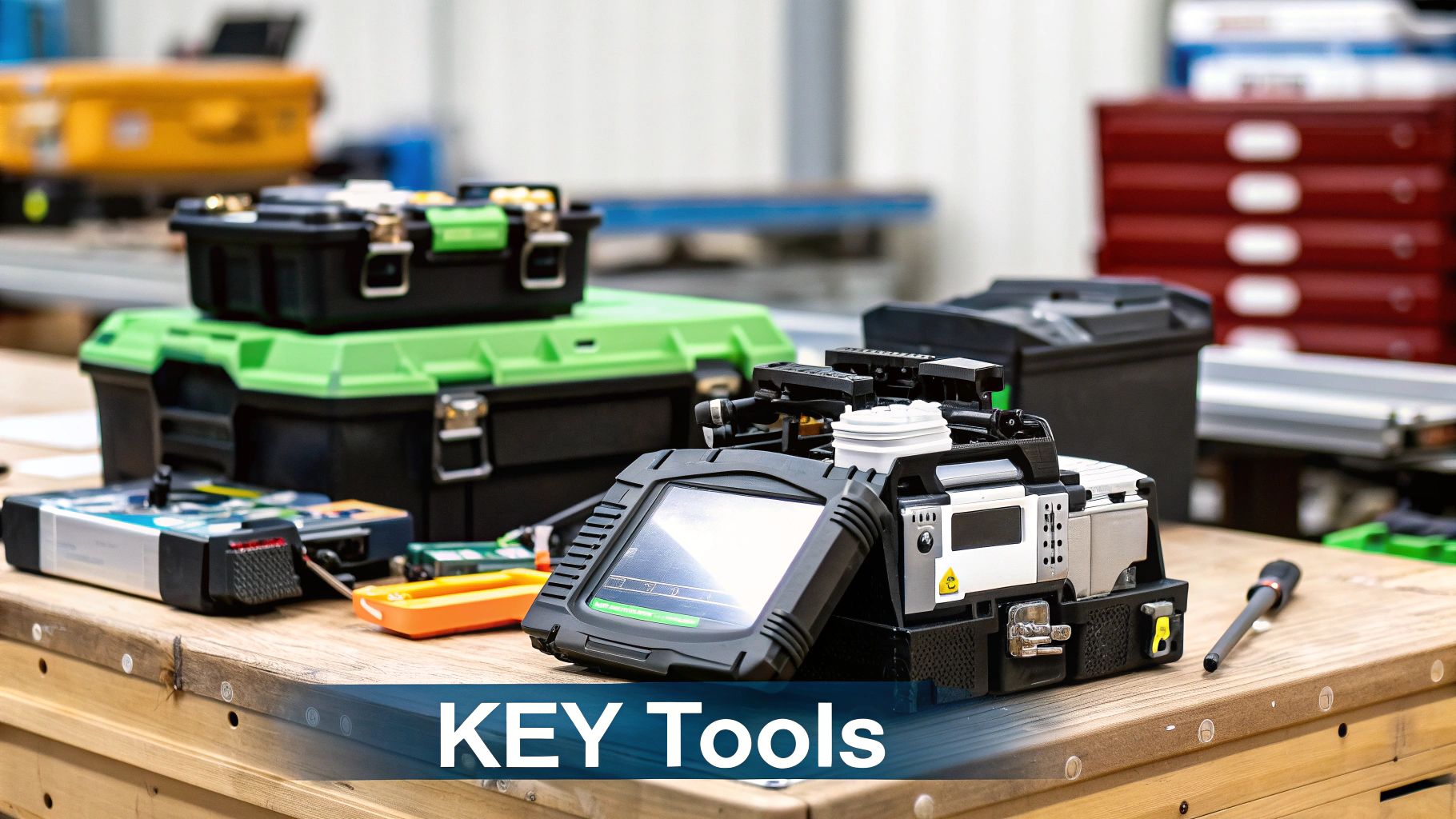Fibre Optic Splicing Mastery: Expert Canadian Guide
- Laserverse

- Jun 3
- 11 min read
Mastering Fibre Optic Splicing Fundamentals

For any professional technician in Canada, understanding the core principles of fibre optic splicing is essential. The journey to mastering this critical skill begins with understanding how light transmits through these fragile glass fibres and why precision is paramount for every connection.
The Importance of Precision in Fibre Optic Splicing
Proper splicing techniques are vital for preventing signal degradation. This is a critical factor in maintaining network integrity, especially across Canada's diverse and challenging landscapes. Think of a fibre optic cable as similar to a water pipe: leaks or kinks reduce water pressure and flow. Similarly, imprecise splicing introduces loss to the light signal, weakening its strength and potentially interrupting data transmission.
This can lead to slower internet speeds, dropped calls, and overall network instability. These are issues that any technician wants to avoid. A poorly executed splice can introduce insertion loss, which reduces the signal power at the receiving end.
Return loss, caused by reflections at the splice point, can further disrupt the signal and create interference. Therefore, achieving low loss values in splices is key to optimized network performance.
Understanding Optical Fibre Types in Canada
A variety of optical fibre types are used in Canadian installations, each with unique characteristics and splicing considerations. Single-mode fibre, commonly used in long-haul applications, transmits light in a single pathway. This requires the highest precision during splicing.
Multimode fibre, however, allows light to travel through multiple paths. While this offers more flexibility, careful attention is still needed to minimize signal loss. Understanding these differences is crucial for selecting the right splicing techniques and equipment. Knowing these distinctions helps technicians anticipate and address potential challenges.
The quality of splicing has a direct impact on network performance, setting skilled installers apart. Mastering these fundamentals builds a strong foundation for learning more advanced techniques and allows for informed decision-making on the job.
Choosing Between Fusion And Mechanical Splicing
Not all fiber optic splicing situations are the same. Choosing the right technique, fusion or mechanical splicing, significantly impacts your installation's success in Canada. This section explores the practical applications of both methods, helping you determine when the permanence of fusion justifies its higher equipment cost, and when the speed and simplicity of mechanical splicing better suits temporary repairs or budget-conscious projects.
Fusion Splicing: Permanent Precision
Fusion splicing, the gold standard for permanent fiber optic connections, uses an electric arc to melt two fiber ends together. This creates a continuous, low-loss connection crucial for high-performance networks. Fusion splicing consistently delivers the lowest loss values, typically around 0.02 dB. This makes it ideal for long-haul installations and applications demanding minimal signal degradation. However, the specialized equipment required for fusion splicing represents a significant upfront investment.
Mechanical Splicing: Quick and Cost-Effective
Mechanical splicing aligns and secures two fiber ends within a mechanical device using an index-matching gel. This method is faster and requires less expensive equipment than fusion splicing. While mechanical splices have slightly higher loss values, around 0.2dB, their speed and affordability make them a practical choice for temporary connections, repairs in challenging field conditions, or budget-sensitive projects. Mechanical splicing also offers a practical solution when access to power is limited, a common scenario in some Canadian installations.
Factors Influencing Your Choice
Choosing between fusion and mechanical splicing depends on several factors:
Performance Requirements: High-bandwidth applications requiring minimal signal loss often necessitate fusion splicing. Standard installations may achieve acceptable performance with mechanical splices.
Cost Sensitivity: Fusion splicing involves higher initial equipment costs. Mechanical splicing offers a more budget-friendly option, especially for smaller projects.
Installation Environment: Harsh Canadian weather conditions, remote locations, and time constraints can influence each method's practicality. For example, extreme cold can affect the index-matching gel in mechanical splices, while the need for power for fusion splicers can be challenging in remote areas.
To help visualize the decision-making process, consider the following comparison:
The following table summarizes the key differences between fusion and mechanical splicing:
Feature | Fusion Splicing | Mechanical Splicing |
|---|---|---|
Loss Value | ~0.02 dB | ~0.2 dB |
Cost | High | Low |
Speed | Slower | Faster |
Application | Permanent installations, high-performance networks | Temporary connections, repairs, budget-sensitive projects |
Equipment | Specialized, expensive | Less specialized, affordable |
Power Requirement | Yes | No |
As the table highlights, fusion splicing excels in performance but comes at a higher cost. Mechanical splicing offers a cost-effective and faster alternative, suitable for situations where slightly higher loss is acceptable.

Building Your Splicing Toolkit Strategically
Experienced Canadian technicians often utilize both fusion and mechanical splicing techniques, tailoring their approach to the specific project. Building a versatile splicing toolkit allows you to adapt to diverse scenarios and deliver optimal results. This means carefully considering your typical project needs and balancing the upfront investment in fusion equipment with the flexibility of mechanical splicing solutions. For some, investing in high-quality fusion splicing equipment early on proves cost-effective in the long run due to lower maintenance costs and superior network performance. For others, a phased approach, starting with mechanical splicing and gradually incorporating fusion capabilities as needed, might be a better fit.
Professional Splicing Equipment That Delivers Results

Your fiber optic splicing results hinge on the quality of your equipment. Choosing the right tools is what separates professional installations from amateur efforts. This means investing in equipment capable of withstanding the demands of Canadian field conditions. Let’s delve into the essential tools, from fusion splicers to cleavers, and discuss which investments offer the best value.
Core Splicing Equipment
The foundation of any successful fiber splicing kit rests on a few key pieces of equipment:
Fusion Splicer: A fusion splicer uses an electric arc to precisely fuse two fiber ends, creating a permanent, low-loss connection. Investing in a quality fusion splicer is paramount for optimal performance.
Optical Time-Domain Reflectometer (OTDR): An OTDR is essential for testing and troubleshooting fiber optic networks. This tool sends light pulses through the cable and analyzes the reflections to pinpoint faults, measure signal loss, and verify splice quality.
Fiber Cleaver: Producing clean, perpendicular breaks in the fiber requires a precise fiber cleaver. This ensures accurate alignment and minimizes signal loss during splicing. A poorly cleaved fiber can compromise the entire splice.
Strippers and Crimpers: These tools are vital for preparing the fiber, removing the protective coatings, and applying connectors to pigtails.
Choosing the Right Equipment for Canadian Conditions
Canadian technicians encounter unique challenges, from extreme temperatures to remote work sites. This requires equipment that is durable, reliable, and adaptable. For example, a fusion splicer equipped with a built-in wind protector is invaluable in challenging conditions. Portability is another key factor, particularly for technicians working in remote locations.
Maintenance Practices for Longevity and Performance
Investing in quality equipment is just the first step. Proper maintenance is essential for maximizing the lifespan of your tools and ensuring consistently high splice quality. This includes regular cleaning, calibration, and proper storage. For instance, keeping your cleaver blade clean and sharp ensures accurate fiber breaks, critical for low-loss splices.
Budget Considerations and Essential vs. Nice-to-Have Tools
Assembling a complete splicing kit requires a significant investment. Discerning between essential tools and convenient additions is crucial for budget management. While a high-end OTDR boasts advanced features, a standard model may be sufficient for many applications. Experienced professionals often recommend prioritizing a quality fusion splicer and cleaver as the core of your kit.
Step-By-Step Fusion Splicing Excellence
Achieving fusion splicing mastery involves a precise series of steps, ensuring low-loss, high-quality fiber optic connections. This guide will walk you through each crucial stage, from preparing the fiber to the final protective measures, incorporating practical tips from experienced Canadian technicians. By following these steps, you can consistently achieve, and even surpass, industry-standard splice losses.
Fiber Preparation and Cleaving
A strong fusion splice begins with proper fiber preparation. This involves carefully stripping the fiber's protective coating without damaging the delicate glass core. It's akin to peeling a fragile, thin onion – precision is paramount. Next, the fiber needs cleaving with a high-precision fiber cleaver. A clean, perpendicular cleave is essential for minimizing signal loss. Even a minor angle on the cleaved end can dramatically increase loss and impact network performance.
Alignment and Fusion
After cleaving, the fibers are placed in a fusion splicer for accurate alignment. While modern splicers use automated alignment systems, understanding the fundamentals is important. Precise alignment ensures perfect core positioning for fusion. The splicer uses an electric arc to melt the two fiber ends, creating a permanent bond. Though rapid, this process demands precise control of the fusion parameters, such as arc power and duration, which are vital for optimal fusion.
Fusion Parameter Optimization
Different fiber types require varying fusion parameters. Single-mode fibers, with their smaller core, need different settings than multimode fibers. Understanding these differences is essential for peak splice performance. Environmental factors, such as temperature and humidity, can also influence fusion results. Experienced technicians often adjust parameters based on these conditions for consistent, high-quality splices. While seemingly intricate, this optimization process becomes intuitive with experience.
Protective Sleeve Application
Post-fusion, the spliced area is extremely delicate. Protecting it with a heat-shrink sleeve is crucial. This sleeve reinforces the splice and shields it from the environment. Proper application requires attention to ensure a secure fit without stressing the fiber. This protection safeguards the splice, ensuring long-term reliability, particularly in the challenging Canadian climate. This final step, while simple, protects your work and ensures the connection's longevity. It's the finishing touch that secures your investment and delivers consistent network performance.
Fibre Optic Splicing In Canadian Infrastructure

Canada's telecommunications network stretches across a vast and varied landscape, connecting busy urban centres with remote northern communities. This geographic diversity makes fibre optic splicing a critical skill, ensuring Canadians stay connected from coast to coast. The quality of these splices has a direct impact on network speed and reliability.
Urban Vs. Rural Splicing Challenges
The requirements for fibre optic splices vary considerably across Canada. In densely populated urban areas, the focus is often on high-bandwidth capacity and redundancy. This necessitates precise, low-loss splices to support millions of users.
Connecting data centres and high-rise buildings, for example, requires meticulous splicing techniques to minimize signal degradation over short distances. Urban projects also face logistical hurdles like limited access and tight deadlines, making efficient splicing essential.
Rural connectivity, however, presents a unique set of challenges. Splices must withstand harsh environmental factors, including extreme temperatures, wildlife, and challenging terrain. Longer cable runs also introduce the need for specialized splicing to minimize signal loss over greater distances. Connecting remote communities in Northern Canada, for instance, demands durable splices capable of surviving harsh winters.
Investing in Canada's Connected Future
Canada has made a significant commitment to expanding its fibre optic network. In 2023, the country invested $3.3 billion in optical fibre cables, a substantial portion of the $7.8 billion total investment in communication networks. This investment highlights the importance of building robust digital infrastructure for the future. It also underscores the vital role of fibre optic splicing in ensuring reliable and efficient network performance. For more detailed information, visit Statistics Canada - Telecommunications.
This growth has led to an increased demand for skilled splicing technicians nationwide. Their expertise is essential for everything from large-scale infrastructure projects to ongoing maintenance and repairs. These professionals ensure seamless data flow between urban hubs and expand high-speed internet access in rural and remote areas, contributing to economic growth and improving the quality of life for all Canadians.
Real-World Impact of Quality Splicing
The quality of every fibre optic splice directly impacts the reliability of Canada's communication networks. Reliable connectivity is crucial for supporting essential services like hospitals and schools, as well as enabling individuals to connect with loved ones.
A single faulty splice can cause network outages, disrupting businesses, emergency services, and daily life for millions. Therefore, skilled fibre optic splicing technicians play a critical, often unseen, role in keeping Canada connected.
Testing and Quality Standards for Professional Splicing
After completing a fiber optic splice, rigorous testing is essential to ensure the connection's long-term reliability and performance. This is especially crucial in Canada, where networks must withstand diverse and often harsh environmental conditions. This process involves specialized equipment and adherence to Canadian industry standards.
Splice Loss Measurement Techniques
The primary measure of a splice's quality is its insertion loss, representing the reduction in signal power. This loss, measured in decibels (dB) using an Optical Time-Domain Reflectometer (OTDR), is a key indicator of splice performance. Optical Time-Domain Reflectometer testing is a standard procedure. Think of an OTDR as sending a pulse of light down the fiber and measuring the echoes that return. These reflections provide valuable information.
Lower dB values indicate better splice performance. A well-executed splice minimizes signal loss and ensures efficient data transmission across the network. This is essential for maintaining signal integrity over long distances.
OTDR Testing Protocols
Proper OTDR testing requires following specific protocols. This involves setting appropriate launch and receive parameters based on the fiber type and cable length. Accurate interpretation of OTDR traces is crucial for identifying splice issues. A high reflection peak on the trace could indicate a poorly executed splice or damage to the fiber.
Analyzing these traces helps technicians pinpoint the location and nature of any problems. This allows for targeted repairs and minimizes network downtime. Understanding OTDR traces is a crucial skill for fiber optic technicians.
Canadian Industry Standards for Fiber Optic Splicing
Canadian telecommunications networks adhere to specific standards for acceptable splice loss values. These standards ensure consistent performance across the network and contribute to the overall reliability of the infrastructure. For single-mode fiber, a maximum loss of 0.3 dB per splice is typically required.
To further illustrate these standards, the following table details the acceptable splice loss values for various fiber types used in Canadian networks, along with the corresponding test methods and relevant standards.
To understand the specific requirements for various fiber optic cables within Canadian networks, consult the table below. It details the maximum acceptable loss values, prescribed test methods, and relevant standards. This information is crucial for ensuring compliance and maintaining network quality.
Canadian Splice Loss Standards
Fibre Type | Maximum Loss (dB) | Test Method | Standard |
|---|---|---|---|
Single-Mode | 0.3 | OTDR | CSA T527 |
Multimode (50/125) | 0.2 | OTDR | CSA T527 |
Multimode (62.5/125) | 0.3 | OTDR | CSA T527 |
This table highlights the importance of adhering to specified standards for each fiber type. Maintaining these standards ensures interoperability and reliable performance across the entire network. Consistent application of these standards is key to providing high-quality telecommunications services.
Documentation and Quality Assurance
Documenting splice performance is vital for future maintenance and troubleshooting. This involves recording splice loss values, OTDR traces, and the location of each splice. This documentation creates a valuable resource for future technicians. Accurate records help to quickly identify and address any issues that may arise.
Additionally, implementing systematic quality assurance processes, such as regular OTDR testing and splice loss verification, is crucial. These proactive measures help prevent network failures and ensure long-term client satisfaction. By adhering to these testing and quality standards, Canadian fiber optic technicians contribute to the ongoing reliability of the nation's telecommunications infrastructure.
The Future Of Fibre Splicing Technology In Canada
Canada has a rich history of fibre optic innovation, dating back to the 1981 fibre-to-the-home trials in Manitoba. This pioneering spirit continues to influence modern fibre splicing and suggests a future brimming with exciting advancements. Early adoption, coupled with ongoing investment in fibre optics, has created a strong foundation of splicing expertise within the country. Discover more insights about the history of fibre optic technology.
Automation and AI: The Next Frontier
Building on this foundation, the industry is shifting towards greater automation in fibre optic splicing. Automated splicing machines, some equipped with AI-assisted splice optimization, are changing how technicians work. These technologies offer increased splicing efficiency, fewer human errors, and the potential for lower splice losses.
Next-Generation Splicing Equipment and Evolving Standards
The drive for automation also extends to next-generation splicing equipment. New splicers boast advanced features like automatic fiber identification and core alignment, further improving splicing speed and accuracy. Evolving industry standards in Canada are also raising the bar for splice quality, encouraging manufacturers to create even more precise and reliable equipment. This continuous development ensures Canadian telecommunications networks remain at the forefront of global innovation.
Separating Hype From Reality
While many advancements represent genuine progress, it's essential to separate true benefits from marketing hype. Not every new feature leads to significant real-world improvements. Experienced Canadian technicians stress the importance of a critical approach to new technologies, emphasizing features that genuinely improve efficiency and splice quality within their specific work environments. This practical approach helps technicians make informed decisions about equipment investments and stay ahead of the curve.
Positioning for Future Opportunities
For technicians looking to the future, understanding these trends is crucial for success in Canada's rapidly expanding telecommunications sector. As networks expand and bandwidth demands increase, so will the need for highly skilled splicing professionals. By embracing new technologies, implementing best practices, and continually improving their skills, technicians can take advantage of new opportunities and contribute to the development of Canada's vital communications infrastructure.
Ready to explore the latest in laser cleaning technology for your industrial needs? Visit Laserverse today to discover how our advanced systems can streamline your cleaning processes and optimize your operations.

